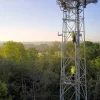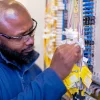BT Group Sees FTTP Broadband Reach 3.5 Million UK Premises

The BT Group has today published their Q2 2020/21 results, which saw Openreach expand their gigabit-capable Fibre-to-the-Premises (FTTP) broadband ISP network to cover 3.5 million UK premises (up from 2.98m last quarter). The full fibre build rate has now hit 40,000 premises per week (up from c.34,000).
The most recent quarter has been quite eventful for BT, not least with speculation growing that they could become the subject of a £15bn takeover attempt (here). Meanwhile Openreach have run into a snag with their latest trial of G.INP (ReTx) technology on ECI based FTTC broadband lines (here) and they may have lost out on a key FTTP contract in Northern Ireland (here), which is despite delivering strong commercial coverage (here).
Speaking of FTTP, Openreach recently announced the next batch of 67 UK areas for their FTTP rollout programme (here) and they’ve added another 51 locations to their future copper phone retirement plan (here). Elsewhere a number of Openreach’s engineers received birthday honours from the Queen (here) and a reward of £20k has been offered to help catch a gang of copper cable thieves in London (here).
Advertisement
Finally, BT’s redundancy plan is facing the possibility of strike action from the CWU (here) and Ofcom have begun a probe of BT’s compliance with their obligations under the new 10Mbps Universal Service Obligation for broadband (here).
Financial Highlights – BT’s Quarterly Change
* BT Group revenue = £5,357m (up from £5,250m)
* BT Group profit after tax = £408m (down from £448m)
* BT Group total net debt = £17,627m (decreased from £18,157m)
BT no longer includes full customer figures for their own retail broadband ISP (this usually means they’re in decline), but they have started doing it for their newest services. For example, BT Consumer reported that they had 598,000 FTTP customers (up from 512K last quarter) and EE’s “5G Ready” base now stands at 1.23 million (up from 374K). Overall 82.4% of BT’s fixed consumer base now take a “superfast broadband” service (up from 81.8% last quarter – mostly FTTC) and this drops to just 2.7% (up from 2.5%) for their FTTP and G.fast based “ultrafast broadband” products.
Separately BT’s KPIs also reveal that the total gross BDUK grant funding deferral (clawback) included in capacity/network remains unchanged on £788m. This reflects public money that is either in the process of or could in the future be returned by BT and reinvested by local authorities to help boost superfast broadband coverage. A big chunk of this has already been re-invested into such contracts or has been provisionally allocated to future ones.
Openreach’s Network
The table below offers a breakdown of fixed line network coverage and take-up by technology on Openreach’s national UK network, which covers the totals for all ISPs that take their products combined (e.g. BT, Sky Broadband, TalkTalk, Zen Internet, Vodafone etc.).
Advertisement
The roll-out of full fibre lines remains the dominant one amongst the two “ultrafast” technologies, with FTTP adding +521,000 premises (up from +404K last quarter) and hybrid fibre G.fast being unchanged. As most people know, G.fast deployments have been suspended in favour of FTTP (expected to be reviewed again in March 2021 but no change is expected). We note that the FTTP build rate is now 40,000 premises per week!
All four major ISPs on Openreach’s network are now selling FTTP and orders grew 100% compared to Q2 last year. Weekly orders have grown from an average of c.7k pre-lockdown to c.13k in September 2020.

The results also reveal that take-up of FTTP is now 18.71% (up from 18.6% last quarter), while G.fast stands at just 4.87% (up from 3.46% last quarter). At this stage of the roll-out we’d normally expect the build rate to be suppressing take-up (i.e. connections being built faster than new customers can sign-up, as well as other dynamic factors like consumer choice and awareness), but this time around Openreach seems to have bucked that trend. Meanwhile G.fast’s take-up is growing slowly now that it’s no longer being deployed, although the appetite for that service remains weak.
Advertisement
Openreach plan to ramp-up their FTTP deployment (target to cover 20 million UK premises by around 2025-2030) and so we wouldn’t be surprised to see that acting to suppress their take-up figures in future quarters, but today’s results are otherwise a very promising indication of strong consumer appetite. We suspect a lot of the recent take-up boost will have been driven by competition pricing among mainstream providers.
Otherwise, one of the best ways to examine take-up is to focus on areas where a technology has been live for 12 and 24 months or longer, but sadly such data is not provided above.
Philip Jansen, CEO of BT Group, said:
“BT delivered financial results in-line with expectations for the first half of the year, thanks to strong operational performance during exceptional circumstances. Customer demand during the pandemic has shown how critical our networks have become, and our significant network investments have helped us double the number of Openreach’s FTTP orders compared to this time last year and have seen our leading 5G network expand to 112 towns and cities across the UK.
We continue to invest to make BT more competitive and I’m pleased to see the quality of our products and services improving. At the same time we are firmly on track with the delivery of our modernisation programme and have delivered £352m in cost savings in the first half of the year.
This performance has given us confidence to raise the lower end of our EBITDA outlook range for this year and publish an EBITDA expectation of at least £7.9bn for 2022/23, with sustainable growth from this level forward. This growth will be driven by the continued recovery from Covid-19, enhanced by sales of our converged and growth products, and by significant savings from our modernisation and cost saving programme. In combination these factors will more than offset legacy product declines.
The growth in EBITDA underpins the planned reinstatement of our dividend next year whilst ensuring that we can continue to drive value-creating investments in our networks and products.”
Elsewhere BT reported that they had delivered £352m in savings through their “modernisation programme” in the first six months of the financial year (this is gross annualised savings at a cost of £163m), which comes ahead of their current plan to achieve £2bn of savings over five years.
Mark is a professional technology writer, IT consultant and computer engineer from Dorset (England), he also founded ISPreview in 1999 and enjoys analysing the latest telecoms and broadband developments. Find me on X (Twitter), Mastodon, Facebook, BlueSky, Threads.net and Linkedin.
« O2 UK to Donate 10,000 Mobiles and Free Service to Digitally Excluded





















































Genuinely impressive to hit 3.5m from a standing start and over 500k in a single quarter signals a serious ability to deliver. This chain is going to be full of people moaning about their own lack of connectivity but this is great progress. Well done Openreach.
It’s like being excited that FTSE is rising when you don’t have the means to partake in the feast.
Of course we’re gonna moan. We’re not part of the party, and some of us don’t even know if we’ll get invited in the next 2 years.
@Spurple: There is nothing about BT deploying fibre. All of this should have started on a wider scale more than a decade ago, it’s now just a catching up in this backwards country. Power companies maintain power lines, water companies their water pipes, etc, nothing news worthy.
One of the real issues that needs to be addressed is to change the overall framework and regulatory environment. It is just a waste of resources to build multiple last-mile network infrastructures to the same premises, digging up the same road multiple times, in many places. The cherry-picking approach is not the correct long-term strategy. Fibre has to be dealt with just like any other utility!
Looking forward to seeing this on my street in 2050.
And there’s the first one!!
@Grazza
It was deliberate. Thank you.
Interesting that income nudges up slightly net debt is down significantly and yet FTTP is rolling out very fast.
Looks like the top floor team have got the numbers under control.
Yes but there are still many uncertainties that can alter their course. The FTTP target of 20m is heavily caveated by investment, return and their realistic resource capabilities. 5G growth healthy but they know they need more bandwidth/frequencies to exploit it. The new centralised PSTN replacement capacity probably still needs to be finalised.
Where they flex will depend heavily on what the Government/Ofcom does next. I just hope they won’t try to be too clever.
The issue will be what happens to the other 9m+ premises and whether they will have an Ultrafast/Giga alternative and who they will be if not.
@Meadmodj
It is all very well BT arguing with OFCOM but if they don’t get to most of the last 9M premises then their income stream is reduced by 9/29: simple maths that. And that is big % reduction in long term stable cash flows.
There are plenty of others who see the business case for a large portion of the 9M so BT can’t use the blind eye + begging bowl technique yet again. The % of genuinely non commercial premises is getting quite small now. Strangely I think HMG have been right to hold back on how the £5Bn pot is to be utilised as holding back has allowed the space to be filled. Personally I would just extend the voucher scheme for the majority of premises as this system is working perfectly well and nobody is crying foul.
OR has always been the cash cow. If they can keep OR as the cash cow then BT can grow.
Particularly if they can get group debt down at the same time and not just borrow to buy “bolts on new shinys” that pretty much always were a disaster.
The issue I have with the vouchers is that they only really works if there is 100% buy-in and subsequent 100% coverage. If, for whatever reason, certain premises decline to participate then they can be left out completely going forward and in my view resulting in a less effective FTTP investment which results in higher public subsidy per premise than a full rollout approach.
I personally favour the future tendering of all non-commercial areas with 100% coverage obligations, but it needs to come with upfront subsidy not drip fed and total open book visibility of the provider costs.
I don’t think it is a question of 20m or 29m premises but more whether the OR resource 16m (ish) resource forecast in 2022-2027 is steered towards non commercial or commercial or not at all. I think BT have already decided that their market share will be reduced considerably and unless there is a return for them its best left.
Going forward I think real rural will be covered by the subsidised schemes, cities/towns will have their overbuild and 5G competing but there could be a sizeable FTTC wilderness even isolated ADSL left in 7 years time depending on the pending Gov/Ofcom decisions.
We know the £5bn will not go far enough and no doubt some of it will go the same way as Track/Trace. So it needs to be spent wisely.
“The issue I have with the vouchers is that they only really works if there is 100% buy-in and subsequent 100% coverage. If, for whatever reason, certain premises decline to participate then they can be left out completely going forward and in my view resulting in a less effective FTTP investment.”
If you are specifically talking about CFP’s then that isn’t quite how it works.
They don’t skip properties that don’t claim the vouchers and only pass the properties that do claim them.
Any properties in-between properties that claim the vouchers will get covered by the rollout, they just don’t contribute to the costs.
OpenReach won’t just bypass those who choose not to contribute.
The exception to this is the outer edge of a chosen CFP coverage area.
If 1 half of a town chooses to participate in a CFP and the other half doesn’t then rightly any rollout should only cover the half of the town that is contributing.
If a CFP is covering a set number of streets they won’t just cover the homes and businesses that claim vouchers but all homes within that set area.
> It is all very well BT arguing with OFCOM but if they don’t get to most of the last 9M premises then their income stream is reduced by 9/29: simple maths that.
I see the opposite view.
Places which have crappy copper phone lines and ADSL, are still providing income to Openreach, as long as customers have no alternative. If they upgrade them to super-duper FTTP then most people will take a basic 40/10 service and the income is about the same. Happy customers, but little return on investment (perhaps only via reduced fault rate and a small number of Ultrafast customers).
The places where they will *lose* income are where there are alternate players – Virgin Media, Cityfibre, Hyperoptic, Gigaclear etc. If they don’t build FTTP to those, then they will lose paying customers off their network, especially where FTTC speeds are poor.
However apart from Virgin, the numbers are small. Cityfibre has only about 0.3m currently, and a final aspiration of 8 million – but those will be in the dense towns and cities where it’s cheap for Openreach to build as well, using their existing ducts and poles.
Hence the number one target for Openreach will be those areas with Virgin coverage, where they can pick up disaffected Virgin customers.
@NE555 Not quite as simple as that though as Openreach would then need to maintain exchanges for ADSL and have ongoing and increasing costs of maintaining aging copper indefinitely. If it is hugely expensive to deploy FTTP they will likely just disconnect these outlying areas and they will need to obtain something under USO and those customers will move to 4G/5G or satellite, or those customers will move themselves to some other infrastructure to keep up with the rest of the UK.
I don’t think OFCOM will allow BT off the hook wrt legacy copper.
Where there is no alternative BT will be made to keep copper going. It gives an incentive to keep upgrading.
Where BT provide FTTP then fair enough to abandon copper.
I think only in the last 1% of cases where the property is so remote that ADSL has never really worked that a different view is warranted.
Copper will be with us for at least 4 years even in 100% FTTP areas and may still be there long afterwards elsewhere. Looking at the OR Fibre First a pattern is emerging. OR will continue to consolidate so that they can reduce cost and pull out the copper by large geographical areas.
Unless an Altnet has the areas not fully covered by FF then Ofcom will be forced to continue the Telephony USO obligation on BT. If telephony stays then copper based services also continue by default. Even in commercial areas Altnets are often ceasing at 65/70% area coverage. So BT could leave the 30/35% until they are ready and then provision FTTP back through the Altnet until the area is covered.
Ofcom could face a legal challenge if it then attempted to prevent OR offering copper based products. They they are more likely to follow the current practice of letting DSL/Landline prices rise so that it encourages users to switch to an Altnet or encourage the Alnet to invest.
In the longterm DSL areas there is nothing of course theoretically stopping OR utilising all the recovered G.fast/FTTC kit and placing it nearer to the customer whilst laying some of the future FTTP infrastructure to feed it. Probably not worth it but you never know.
Real alternatives are of course more use of remote OLTs or EE strategically positioning 5G capacity in certain urban areas.
Many on the forum appear to be experimenting with load balancing DSL/4G or 4G/4G. As the 5G/LTE routers become more common, and importantly cheaper, those considering a 5 or 6 year wait for FTTP may seek alternatives extending the FTTP ROI periods. Particularly as the trend towards personalised broadband will continue.
Awesome to see fttp taking off so quickly now. 40k a week is pretty quick if I’m not mistaken?. Will be ready for it whenever they decide to come install it in Gloucestershire but for now I’m quite happy with my 66mbps fttc speeds
All the Gloucestershire villages around here have Gigaclear already installed as part of the Fastershire scheme.
None at all in my part of Gloucestershire.
There is fttp 3 miles down the road but none here. They came a few years ago and just stuck 1 cabinet 270m away.
Any mention of the remaining exchanges to be upgraded to 21CN?
Appreciate its not a big corporate issue but it would be helpful if the the remaining 50 exchanges (yes, my own!) are finally upgraded
Can you get FTTC/FTTP? That’s your 21CN upgrade. I very much doubt they’ll upgrade the last few exchanges to ADSL2+
No fibre anywhere near (besides a fibre cable used for the local mast)
It has to happen and probably via R100 although OR suggested to me that it might happen this year
https://www.ispreview.co.uk/index.php/2019/12/after-15-years-bt-21cn-wbc-still-has-98-exchanges-to-upgrade.html
I’d expect that these final exchanges are a lost cause – no point running fibre to these “sheds” when you can cut them out of the picture altogether
Since R100 demands 30Mbps minimum then ADSL2+ would be unsuitable anyway. Now that they’ve decided FTTP is lovely stuff, then you could be in quite for an uplift if you’re still on up to 8Mbps ADSL
I’ve enquired about ANY broadband service over 5 months for the last 12 years. BT(OPENREACH) supplied the slower but better copper alternative in my area, a city centre location, fir a short period of time but then withdrew it. They didn’t make it known to BT customers in the area that it was available!!!!
frandy duffy
Its Openreach (should)f not be a reference to bT in that
it would have been made available to all providers at the same time (that consume the fibre product) it would be up to your chosen service provider of choice (whether that was Bt, talk talk, sky or one of the other 600 + providers openreach supports whether it chose to sell them or market them based on their own commercial criteria